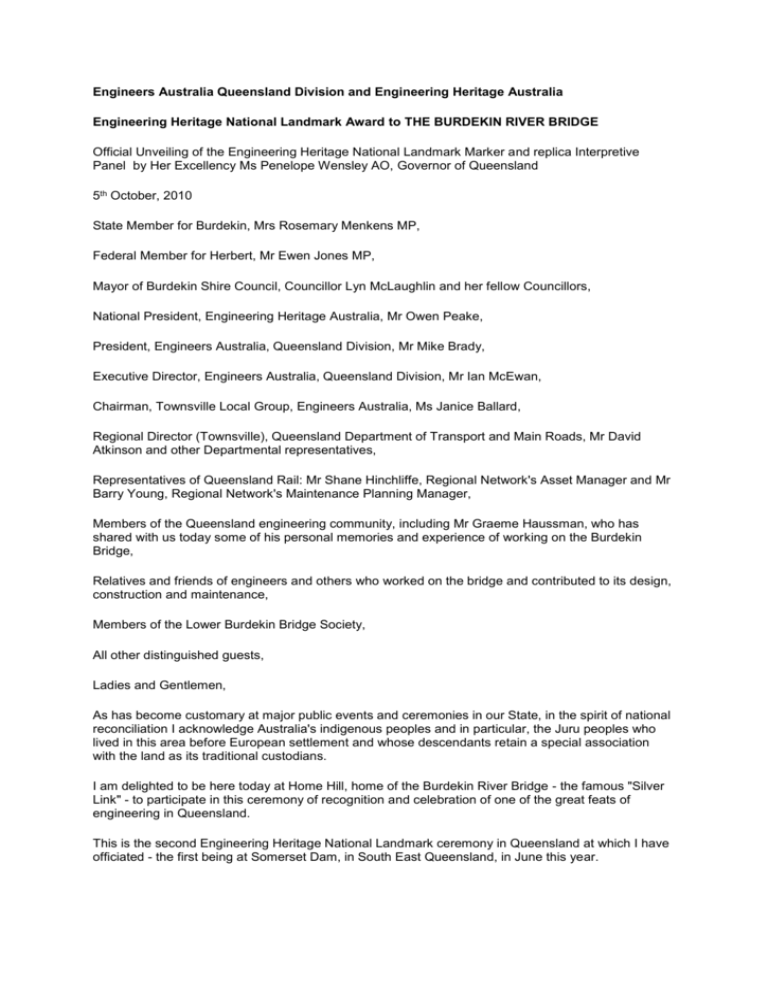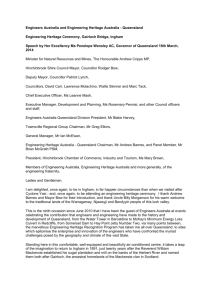Her Excellency Ms Penelope Wensley AO, Governor of Queensland
advertisement

Engineers Australia Queensland Division and Engineering Heritage Australia Engineering Heritage National Landmark Award to THE BURDEKIN RIVER BRIDGE Official Unveiling of the Engineering Heritage National Landmark Marker and replica Interpretive Panel by Her Excellency Ms Penelope Wensley AO, Governor of Queensland 5th October, 2010 State Member for Burdekin, Mrs Rosemary Menkens MP, Federal Member for Herbert, Mr Ewen Jones MP, Mayor of Burdekin Shire Council, Councillor Lyn McLaughlin and her fellow Councillors, National President, Engineering Heritage Australia, Mr Owen Peake, President, Engineers Australia, Queensland Division, Mr Mike Brady, Executive Director, Engineers Australia, Queensland Division, Mr Ian McEwan, Chairman, Townsville Local Group, Engineers Australia, Ms Janice Ballard, Regional Director (Townsville), Queensland Department of Transport and Main Roads, Mr David Atkinson and other Departmental representatives, Representatives of Queensland Rail: Mr Shane Hinchliffe, Regional Network's Asset Manager and Mr Barry Young, Regional Network's Maintenance Planning Manager, Members of the Queensland engineering community, including Mr Graeme Haussman, who has shared with us today some of his personal memories and experience of working on the Burdekin Bridge, Relatives and friends of engineers and others who worked on the bridge and contributed to its design, construction and maintenance, Members of the Lower Burdekin Bridge Society, All other distinguished guests, Ladies and Gentlemen, As has become customary at major public events and ceremonies in our State, in the spirit of national reconciliation I acknowledge Australia's indigenous peoples and in particular, the Juru peoples who lived in this area before European settlement and whose descendants retain a special association with the land as its traditional custodians. I am delighted to be here today at Home Hill, home of the Burdekin River Bridge - the famous "Silver Link" - to participate in this ceremony of recognition and celebration of one of the great feats of engineering in Queensland. This is the second Engineering Heritage National Landmark ceremony in Queensland at which I have officiated - the first being at Somerset Dam, in South East Queensland, in June this year. It seems very fitting to me - and no surprise - that these two significant Engineering Heritage National Landmark Awards to our State have been given to honour ingenious and clever solutions to hydrological challenges, because Queensland, with its seasonal changes, its contrasts of almost unbearable scarcity of water with incredible abundance; and with climate and water cycles that are still imperfectly understood, daily presents difficult and complex problems for Queensland engineers, who must rise to the challenge to provide the solid and reliable infrastructure - like the Somerset Dam, and like the Burdekin River Bridge - upon which Queensland depends. As Owen Peake and Mike Brady will recall from the Somerset Dam ceremony, I have a strong interest in Queensland's history and heritage and a particular interest in Queensland's engineering history, not least because engineering has been the profession of choice through four generations of men in my family. My great uncle, Alf McCullough, a Mechanical and Electrical Engineer who features in the publication "Eminent Queensland Engineers", worked with distinction here in North Queensland, including as Chief Engineer of the Townsville Electric and Water Authority from 1932-1938. While construction on the Burdekin Bridge did not commence until April 1947, some 9 years after he left for Brisbane to become effectively Chief Engineer of City Electric Light Co in Brisbane, he was keenly interested in the development of the North, so I have no doubt would have been an enthusiastic supporter of the creation of this vital piece of Northern infrastructure to replace the floodprone Inkerman Bridge - and greatly interested in the innovative solutions developed to respond to the engineering challenges its construction involved. I am very conscious that I am surrounded by engineers and experts, but I don't think you have to be an engineer to appreciate the extreme nature of the challenges the Burdekin River posed to those seeking to span its reach. The Inkerman Bridge which preceded the "Silver Link" was so overwhelmed by the temperamental Burdekin River that it became commonplace for the railway line to be impassable on an average of 17 days a year, and the road an average of 40 days a year. (There is a photo in our family archives from the 1920's, showing a car being towed over the Burdekin River by a team of horses - with the railway bridge in the photo - and I have learned that our cousins from Mossman were often stopped at the Burdekin on their way back to school on the train. In fact, one of them, Judith Crawford, now Henderson, whose birthday is on the 26th of January, was often forced to celebrate it on the banks of the Burdekin!) Apart from the flooding, beneath the river is a bed of sand 150 feet thick, so there was no substantial bearing material for the bridge to be founded upon - indeed, the Burdekin Bridge is said to be the only bridge in Australia that has been built without a firm foothold. And then there was the length - the bridge had to span this sprawling river bed - 097 metres (or 3,600 feet) - to put it into perspective, that is a span that is longer than the Sydney Harbour Bridge, longer than the Hawkesbury Bridge and longer than Brisbane's Story Bridge. Given the strong desire by the people of the North for a stable and reliable rail and road crossing since at least the 1800s, the length of time taken to develop the "Silver Link" is testimony, in part, to the engineering challenges of the task - and to the exigencies imposed by two world wars. As the politicians and public servants in this audience know, engineering challenges combined with economic challenges can be a deadly - if not fatal - combination in public policy terms, and the successful construction of the Burdekin Bridge is thus not only a reflection of the ingenuity of our Queensland engineers, but a tribute to the determination of this community to see this vital piece of infrastructure become a solid reality, for the benefit of the region and of the State. Many, many people were responsible for the design and construction of the Silver Link. But principally, the excellent heritage nomination for the Bridge prepared by Anthony Carey of the Queensland Panel of Engineering Heritage Australia and Ervin Smith of the Department of Main Roads, identifies the following as playing especially pivotal roles: Mr H.G. Bramed, Senior Engineer for Design (Structures), Mr W. Hansen, Engineer-in-Charge on site during construction, Mr S. Thompson - Superintendent of Steel Erection, Mr H.W. Fisher - the Coordinator General's Department Steel Inspector, and Messrs J.A. Holt and J.E. Kindler, Chief Engineer and Deputy Chief Engineer respectively, during design of the superstructure. And to that list, I would add Mr H.A. Lowe, the Resident Engineer who so impressed Graeme Haussman during the time he worked on the bridge. They must all have been very proud to have been associated with this great engineering project and of what they achieved in bringing it to completion - as must their families, many of whom are here today. Likewise, the brave divers who plunged into the depths to check for blockages, drop off materials and seal off the pipes are worthy of recognition. I shuddered today listening to Graeme Haussman's story of his brief and painful venture into the depths and earlier, as I was preparing for today's event, reading some of the descriptions of the divers, recalling their experiences. One said "it's pretty hard work ... you'd come up and be glad to see the sunshine"; and another, "All that work was done by feel. After you left the surface, after you disappeared, it was all black." While their names may not be known to the occupants of the 7074 vehicles that cross the bridge each day, nor to the occupants of the average 84 road trains; and nor may the drivers of the average 295 small trucks that cross the bridge every day, busily pursuing commerce and trade, be aware of their achievements, they are there - in the nine reinforced concrete caissons and the two abutments that securely hold the bridge in its bed of sand, and in the arches of steel that frame the ever-changing view of the Burdekin River and its banks - a constant testimony to their bravery, skill and tenacity. Similarly, regular bridge-crossers, who drive securely over the river in drought and in flood, who slow to admire the view or perhaps for the unpredictable torrential downpours that are such a feature of the northern climate, would be unaware of the names of the men who steered the project: the Coordinator General of Public Works, Sir John Kemp; the Commissioner of Main Roads, Mr D.A Crawford and a host of others, but as a long-term former public servant, I must say I admire the level of cross-departmental cooperation the construction of the bridge must have entailed! And knowing now about the immense challenges the project presented to those charged with building it, I would wish those thousands of bridge-crossers, taking the ease and safety of their passage for granted, might spare a thought, of admiration and appreciation, for those construction engineers. Reading behind the precise language of the heritage nomination I could sense the frustration of the construction team at repeated delays caused by flooding, and the difficulties in retaining trained staff (still an issue today) which led to the innovative use of high-tensile bolts for field connections in place of the more traditional method of riveting. At the time, no other Australian bridge had ever been constructed this way. It was ‘extreme engineering', by any definition, and the fact that there are no plans to replace the bridge - indeed, there are only proposals to duplicate it - must be a source of great pride and satisfaction to the engineers who so carefully plotted the design of the new span (and, I imagine, of great relief to Queensland's current politicians and planners, at the national, regional and local level, who, according to assessments of the Bridge's strength, capacity and longevity, need not worry about finding the resources for a replacement for at least another 100 years. So there's another bravo for those who built it!) As I said at the outset, I have a genuine interest in engineering, and writing about the topic tends to catch my eye, and so I was drawn to a small piece published last month in the Spectator Magazine by the British finance journalist Martin Vander Weyer, where he was, fittingly, writing about another bridge - the viaduct at Millau over the River Tarn in France. I visited Millau during my posting as Australia's Ambassador to France, and have seen for myself this dramatic structure, which appears to soar across space, lifting, almost flying, travellers across a plunging chasm. Seeing it, Vander Weyer was moved to write: "... great engineering has the power to boost the non-economic quantum of ‘general wellbeing' - to lift the soul, in other words ..." The opening of the Burdekin Bridge on 15th June, 1957 must have lifted the soul of the peoples of Ayr and Home Hill and further afield, as they walked across the Bridge after the cutting of the ribbon, as indeed it lifts the soul today to drive over the Burdekin, one of the greatest of our Northern Rivers, with its ever-shifting path over its vast bed, its lush tropical surrounds and abundant birdlife, viewed through the sturdy frame of the "Silver Link", which so reliably and so dependably connects North and Southern Queensland. As Governor of Queensland, I am very proud to see the Burdekin River Bridge recognised as one of the great engineering achievements in our State and country, and the tribute this Award pays to our Queensland engineers. I thank and congratulate everyone involved with the conferring of this recognition and with the organisation of today's ceremony; and it is now with the pleasure that I invite Mr David Atkinson, Regional Director of the Queensland Department of Main Roads and Transport, to join me to unveil this replica interpretive panel, alongside this Heritage Marker, proclaiming the Burdekin River Bridge as an Engineering Heritage National Landmark. Thank you. Downloaded on 8 Dec 2014 from http://web.archive.org/web/20140225005604/http://www.govhouse.qld.gov.au/the_governor/speeches _articles.aspx








